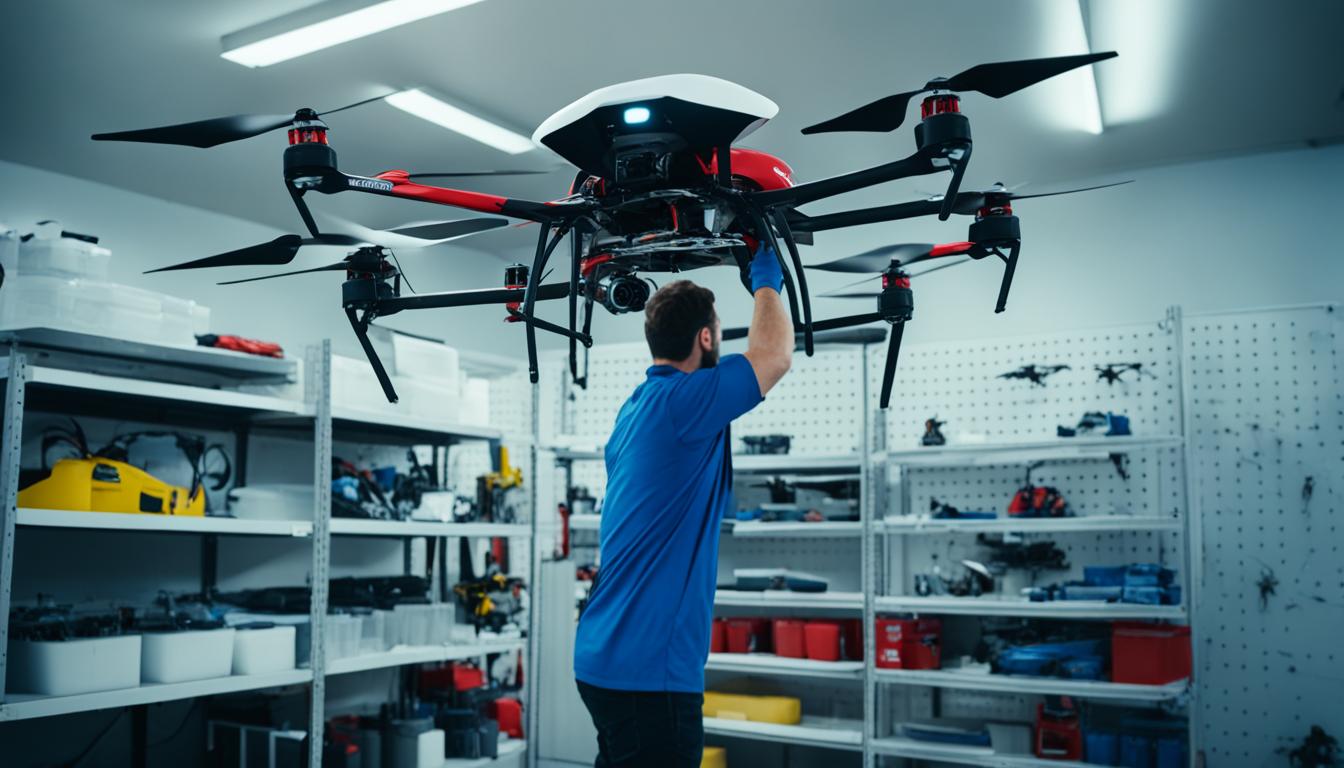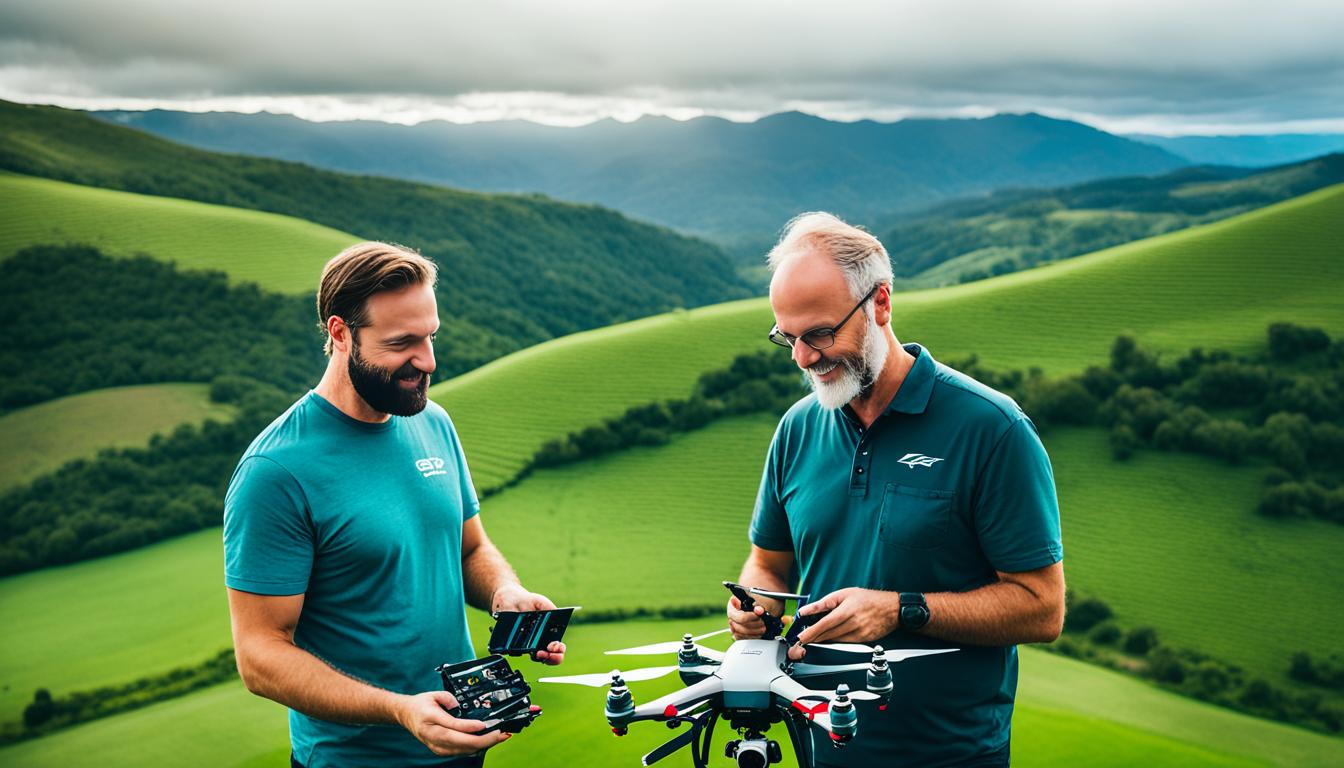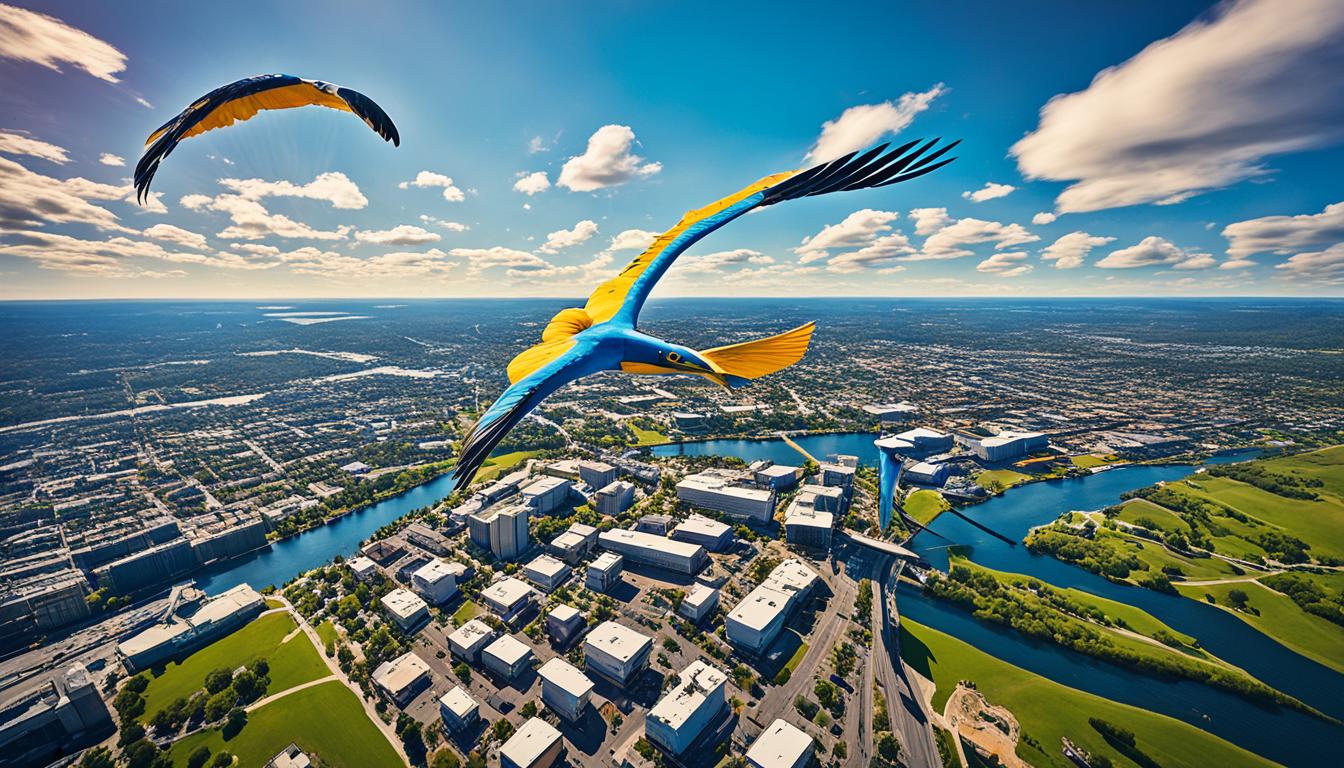Proper maintenance is essential for maximizing the lifespan and performance of your drone. By following these tips and best practices, you can ensure that your drone stays in top shape, avoiding costly repairs or replacements and improving your overall flying experience.
At [Brand Name], we understand the importance of maintaining your drone and keeping it in optimal condition. That’s why we’ve put together this comprehensive guide to help you take care of your UAV. Whether you’re a beginner or an experienced drone enthusiast, this article will provide you with valuable insights and a practical checklist to keep your drone performing at its best.
Key Takeaways:
- Maintaining Your Drone is crucial for extending its lifespan and improving performance.
- Regular inspections allow you to identify signs of damage or wear early on.
- Proper cleaning helps prevent dirt and debris from affecting your drone’s performance.
- Storage and transportation care are essential for protecting your drone from damage.
- By following best practices, you can ensure safe and reliable flights with your drone.
Regular Drone Inspections
Regularly inspecting your drone is essential for ensuring its performance and safety. By conducting thorough inspections, you can identify any signs of damage or wear that may affect the drone’s functionality. Let’s take a closer look at the key components that should be examined during regular drone inspections.
Drone Frame
Start by inspecting the drone’s frame for any cracks or loose components. A sturdy and intact frame is crucial for maintaining the drone’s structural integrity, stability, and overall durability.
Motors
Check the motors for signs of wear or damage. Make sure they spin freely and smoothly. Faulty or damaged motors can lead to reduced flight performance and may compromise the overall operation of the drone.
Propellers
Examine the propellers for any cracks, warping, or other forms of damage. Damaged propellers can affect the drone’s balance, stability, and flight efficiency. It is important to ensure that all propellers are in good condition before every flight.
Battery
Inspect the drone’s battery for any swelling or leakage. A swollen battery is a sign of possible internal damage and should be replaced immediately. Leaking batteries can be hazardous and may damage the drone’s internal components.
Camera and Gimbal
Check the camera and gimbal for any signs of damage or wear. Ensure that the camera lens is clean and free from scratches. The gimbal should be secure and properly calibrated to maintain stable and smooth footage.
Performing regular inspections will help you catch any issues early on, allowing you to take necessary action and prevent more extensive damage or malfunctions. Remember to document the condition of your drone and any repairs or maintenance performed during each inspection.
Regular inspections are the foundation of a well-maintained drone. They help identify potential issues before they become major problems, ensuring safe and reliable flights. By being proactive in conducting these inspections, you can maximize the lifespan and performance of your drone.
Next, in Section 3, we will discuss the importance of proper drone cleaning and maintenance to ensure optimal performance and longevity.
Proper Drone Cleaning
Keeping your drone clean is essential for maintaining its performance and preventing damage from dirt or debris. Regular cleaning not only helps improve the longevity of your drone but also ensures that it functions optimally during flights. To achieve proper cleaning, here are some essential tools and methods you can use:
Cleaning Tools
- Soft brush or compressed air: Use a soft brush or compressed air to remove dirt and debris from the frame, motors, and propellers. Be gentle to avoid causing any damage.
- Damp cloth and mild cleaner: For stubborn dirt or smudges on the battery or camera, use a damp cloth with a mild cleaner to wipe them off. Make sure to use a gentle cleaner to avoid damaging any electronic components.
Cleaning Methods
Follow these steps to clean your drone effectively:
- Power off the drone: Before cleaning, make sure to power off your drone and remove the batteries.
- Gently brush off debris: Use a soft brush or compressed air to remove any loose dirt or debris from the frame, motors, and propellers. Pay attention to hard-to-reach areas.
- Wipe the camera and battery: Using a damp cloth with a mild cleaner, wipe the camera lens and battery to remove any smudges or fingerprints. Be careful not to get any moisture inside the drone.
- Dry thoroughly: After cleaning, allow your drone to air dry completely before reassembling or storing it.
Pro Tip: Always refer to your drone’s user manual for specific cleaning instructions and any recommended cleaning products.
Regular cleaning of your drone will help keep it in optimal condition, ensuring smooth flights and extending its overall lifespan. By following proper cleaning techniques and using the appropriate tools, you can maintain the performance and reliability of your drone for years to come.
Dos and Don’ts of Drone Cleaning:
| Dos | Don’ts |
|---|---|
| Do use a soft brush or compressed air to remove dirt and debris. | Don’t use harsh cleaning chemicals that could damage electronic components. |
| Do use a damp cloth with a mild cleaner for stubborn dirt. | Don’t spray water directly onto the drone. |
| Do refer to the user manual for specific cleaning instructions. | Don’t use excessive force when cleaning delicate parts. |
| Do allow the drone to dry completely before reassembling or storing. | Don’t clean the drone while it is powered on. |
Drone Storage and Transportation Care
Proper storage and transportation care are crucial for protecting your drone from damage. By following these essential practices, you can ensure that your drone remains in excellent condition, ready for your next flight.
Store in a Cool and Dry Place
When not in use, it’s important to store your drone in a cool and dry place. This will help prevent any moisture damage and prolong the lifespan of your equipment. Find a dedicated storage area, away from direct sunlight or any heat sources, to maintain optimal conditions for your drone.
Battery Maintenance
Take care of your drone’s battery by maintaining it at around 50% charge when storing for extended periods. This charge level is ideal for battery longevity and helps prevent over-discharge or overcharge issues. Consider investing in a battery storage bag or case to provide an extra layer of protection for your battery.
Protective Carrying Case
Invest in a high-quality, protective carrying case specifically designed for your drone model. A well-fitted case will keep your drone secure during transportation and shield it from any potential impacts or bumps. Look for a case with cushioned interiors and compartments for accessories, ensuring everything has its place.

Propeller Removal
Prior to storing or transporting your drone, it’s advisable to remove the propellers. This prevents any accidental movements or damage to the propellers during transit. Safely store the propellers in a labeled, separate container to keep them organized and protected.
Gimbal Security
The gimbal is a delicate component of your drone. To protect it from damage, secure it properly before storing or transporting your drone. Many drones have a lock mechanism or protective cover for the gimbal. Follow the manufacturer’s instructions to ensure the gimbal is secured in place to prevent any potential damage.
By adhering to these drone storage and transportation care practices, you can safeguard your drone and ensure it remains in optimal condition. Protecting your investment will lead to more enjoyable flights and peace of mind.
Conclusion
Maintaining your drone is of utmost importance to ensure enhanced performance, an extended lifespan, and safe and reliable flights. By following the tips and best practices discussed in this article, you can optimize the performance of your drone and maximize the return on your UAV investment.
Regular inspections allow you to identify any signs of damage or wear early on so that you can take necessary action and prevent any further issues. Proper cleaning techniques help keep your drone free from dirt and debris, allowing it to function at its best. Additionally, proper storage and transportation care protect your drone from potential damage during transit.
By prioritizing drone maintenance and following the recommended practices, you can enjoy improved flight performance, prolong the lifespan of your drone, and ensure safe and reliable flights. So remember, invest your time in maintaining your drone to make the most out of your UAV experience.
FAQ
Why is drone maintenance important?
Proper drone maintenance is crucial for ensuring the longevity and optimal performance of your UAV. It helps extend the lifespan of your drone, improve its performance, and avoid costly repairs or replacements.
What should I inspect during drone maintenance?
During drone maintenance, you should inspect the frame for cracks or loose components, the motors for signs of wear or damage, the propellers for cracks or warping, the battery for swelling or leakage, and the camera and gimbal for any damage or wear.
How should I clean my drone?
To clean your drone, use appropriate tools and methods. Use a soft brush or compressed air to remove dirt and debris from hard-to-reach areas. For stubborn dirt, use a damp cloth with a mild cleaner, ensuring no moisture enters the motors or electronic components.
How should I store and transport my drone?
Store your drone in a cool, dry place away from direct sunlight or heat sources. Maintain the battery at around 50% charge for longevity. Use a protective carrying case specifically designed for your drone model to transport it safely. Remove the propellers and secure the gimbal to prevent damage during transit.
Are the Maintenance Tips and Best Practices for Drones Useful When Traveling with Them?
When traveling with drones, it’s essential to follow the specific regulations in each location. Researching traveling with drones tips regulations before your trip can help you avoid any legal issues. Additionally, keeping your drone well-maintained is crucial for smooth and safe flying during your travels.




